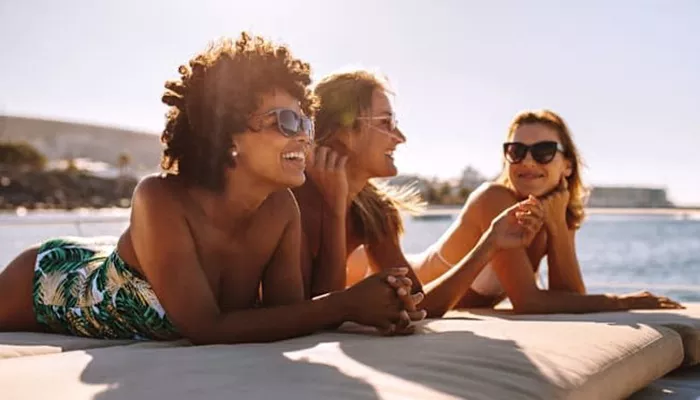A worrying new trend circulating on social media is drawing growing concern from health experts, with many fearing it could have dangerous consequences for young people’s health.
Across platforms like TikTok and Instagram, a rising number of young users are proudly displaying their sun tan lines, and some are even sharing their self-styled “tanning routines.” The trend, which includes videos of sunbathers comparing their tan lines and seeking out high UV conditions for optimal tanning, has sparked alarm among public health advocates.
A Troubling Trend on TikTok and Instagram
“I could not believe this when I saw it,” said Today’s Lara Vella during a recent conversation with Sally Sitou and John Mangos. “The hashtag #sunburnttanlines has more than 200 million views on TikTok,” Vella noted, expressing her disbelief at the growing popularity of the trend.
Sally Sitou, a public health advocate, called the phenomenon “a really disturbing trend,” emphasizing the potential harm it could cause. “This is part of the reason we wanted to restrict social media use for children under 16,” Sitou explained. “They are impressionable, and we don’t want them adopting harmful trends like this.”
The rise of this trend is especially concerning given the success of past public health campaigns, such as Australia’s iconic “Slip, Slop, Slap,” which aimed to reduce sun exposure and skin damage. However, as Sitou pointed out, these crucial messages appear to be losing their effectiveness among younger generations.
Reinforcing Public Health Messages
“The ‘Slip, Slop, Slap’ campaign was successful for a reason,” Sitou added. “We need to keep reinforcing those messages about sun safety, especially now. Tanning is not healthy.”
John Mangos, also on the Today panel, expressed deep concern over the trend’s potential consequences. “It’s very worrying,” he said bluntly. “First off, who even thinks that this is a good look? In Australia alone, a million people get treated for melanoma every year. Around 1,500 Australians die from melanoma annually, and 15,000 new cases are diagnosed each year. The statistics are clear—this is a no-brainer.”
Mangos urged the public to take the message of sun safety seriously. “Maybe the way to reach young people is by showing them the long-term effects of tanning. The most aging thing you can do to your skin is expose it to the sun. It’s time to revisit the ‘Slip, Slop, Slap’ campaign. It was incredibly successful in the past, and it can save lives today.”
The Resurgence of Sun Tanning on Social Media
Although sun tanning has been a long-standing trend, its resurgence is now being fueled by social media platforms, with content creators sharing their experiences with sun exposure. These creators post videos of their tan lines and discuss their tanning routines, often in search of the perfect “sun-kissed” look. Some even actively seek out high UV days, seeing them as an opportunity for better tans.
This social media-driven resurgence of tanning culture first gained momentum earlier this year in the U.S. during the summer. Now that Australia is experiencing its summer season, the trend has made its way down under, gaining traction among local influencers and their followers.
Despite the popularity of the trend, Australian health authorities remain adamant that there is nothing healthy about a tan. “The desire for a tan is still prevalent, especially among young Australians,” said a representative from the Cancer Council. “New research shows that a significant portion of young people aged 18-30 intentionally or unintentionally suntan. In fact, almost 9 in 10 young people are engaging in sun exposure to get a tan.”
The Risks of Tanning and Skin Cancer
Statistics reveal that tanning is not only harmful, but it also poses a significant risk to health. Nearly two-thirds of Australians will be diagnosed with skin cancer in their lifetime, with nearly 2,000 deaths annually due to skin cancer, according to the Cancer Council. Shockingly, skin cancer remains one of the most preventable cancers, yet the rates of diagnosis continue to rise.
The Cancer Council also highlights that even brief exposure to the sun—just 15 minutes—can begin to damage the skin, increasing the risk of both skin cancer and premature aging. In fact, up to 80 percent of premature aging is caused by sun exposure.
Experts are urging Australians to rethink their relationship with the sun, as the normalization of tanning contributes to the alarming rise in skin cancer cases. “Normalizing suntanning is causing skin cancer to trend,” the Cancer Council stated in a recent report.
For more information on sun safety and the risks associated with tanning, the Cancer Council’s website offers resources and guidelines on how to protect skin from the harmful effects of UV rays.
A Call for Change
As health experts continue to sound the alarm about the dangers of sun exposure, it’s clear that public health messaging needs to be revived and reinforced. The growing social media trend of tanning—while seemingly innocent to some—has serious consequences that can affect young people’s health for years to come.
Related topic:
Avita Medical Gains FDA Approval for RECELL GO Mini
Katie Price and JJ Slater Share Botox Appointment, Quash Split Rumors
NOLAHOUR Expands Global Reach with SBA Partnership


